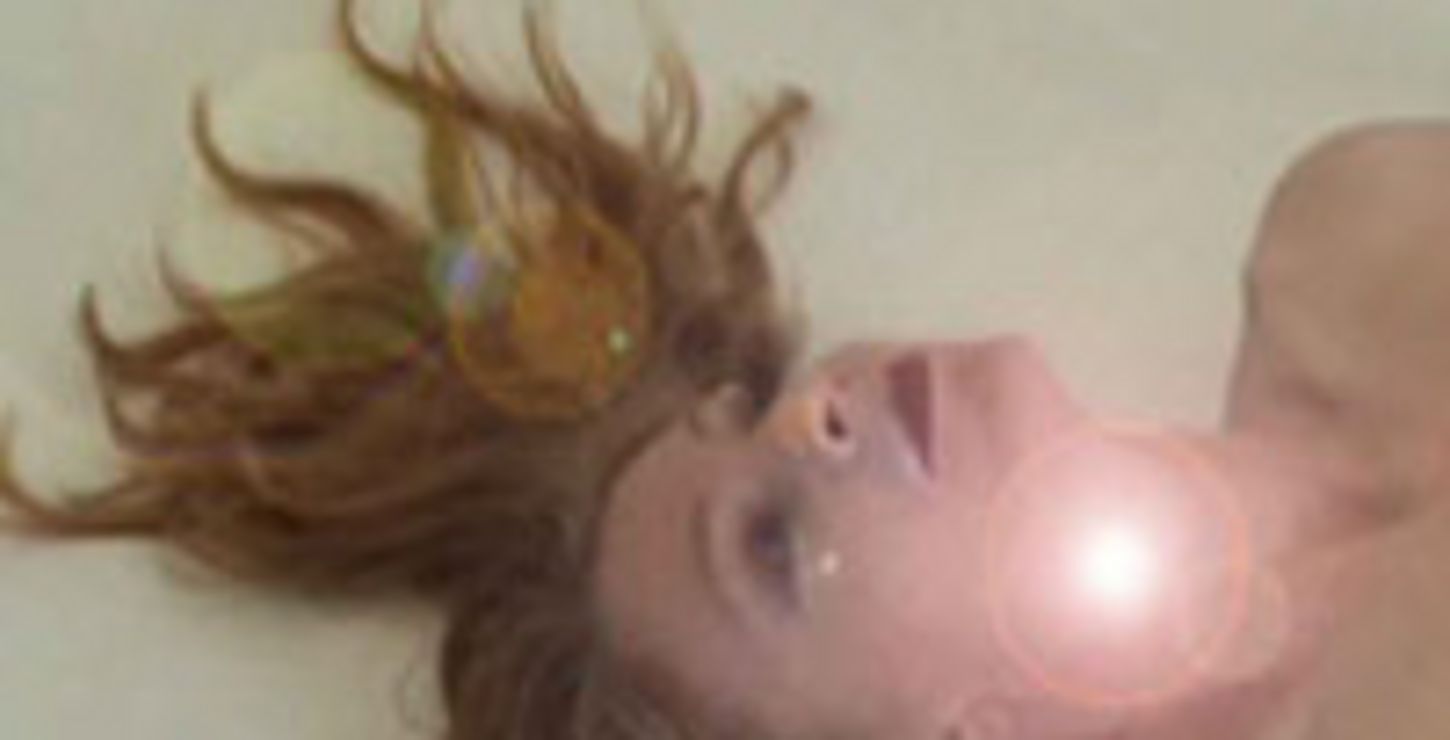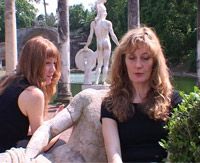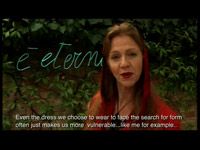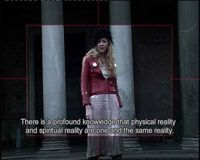Film and Video Gallery 179, first floor
Main Building

The Fashion Weather Forecast 2012 2008 DV master transferred to DVD 19' 08" Courtesy of the artist
The subject of investigation of Italian filmmaker Anita Sieff is human communication as a means of both social inquiry and visual representation. In her films, fragmented and at times abstract dialogues between diverse characters become the focus of attention as women and men question their relationship with each other in precisely allusive urban contexts. Interpersonal relations become the battling ground where identities are constructed, beliefs debated, and emotions examined.
Film that honors the meaning of film... var f_divname="mp3player"; var f_width=133; var f_height=110; var f_file="Anita Sieff On Public,Anita Sieff Public Love,Anita Sieff Fashion Weather Forecast,Anita Sieff Film,Anita Sieff Urban Settings"; var f_filetype="exhibitionMinutes"; var f_title="On Public,Public Love,Fashion Weather,Film,Urban Settings"; Listen to or download artist Anita Sieff's 5-part Podcast. Available in There is a sense of vulnerability and fragility in the scenarios that Sieff constructs as she explores the deeply human desire to be part of a community which is equated here not only with the public realm but also with the most basic relationship between people, that of love and friendship. Lovers, friends, and strangers gather, confront each other, and retreat into cityscapes that surround them perpetually, becoming characters in their own right. In Sieff's films, New York and Venice are recurring presences that serve not only as a background but also weigh upon and seemingly overdetermine those emotional exchanges. Stylistically, Sieff's work evokes film directors such as Ingmar Bergman, Jean-Luc Godard, and Luchino Visconti, but her frame of reference also includes music video clips and soap opera – more popular forms of entertainment disseminated by television. These references are imaginatively employed to create non-linear, utterly discursive, but also playful and witty narratives that captivate and engage the viewers. This is Sieff's first solo exhibition in an American museum.

On Public 2006 DV master transferred to DVD 17’ 52” Courtesy of the artist
Two women talk against a striking background of ancient ruins. There are shadows that crawl across a broken Roman pavement as the indolent sun rises. The conversation is fragmented, insistently winding around the sense of something lost. The weather is splendid. No men are present, neither dressed in togas nor performing any of the rituals of a lost Republic as there is no Empire to defend. There are just these two women with musical voices, whose age we cannot guess, passionately talking about something lost. This is how Anita Sieff begins her film On Public and how she announces what would become a larger project of subsequent and systematically shot short films. This series of films mourns a certain notion of community but also opens the doors for its possible reinvention, as if mourning could sometimes become the most effective form of celebration. But let's return to On Public, because this is the subject of the scintillating dialogue between the two women. One of them asks, "Why have you stopped it?" The other responds, "Because it is not possible anymore." Her answer negates but her words and expression are not of denial, but of joy. In this film, as in much of Sieff's work, the topic of conversation seems endlessly abstract. For the audience, On Public may signify primarily the public dimension of interpersonal relationships, the res publica, or the very foundation of the public sphere as defined in modern times. When one of the women laments the loss of "public," she seems to argue that any dimension of public solidarity—the very possibility of a community—has become or is already lost. The answers of Monica Samassa (an actress in many of Sieff's recent films) are playful yet equally endowed with a classical sobriety. For her there can be no more "public," at least not in its traditional meaning. Only after coming to terms with this fact can there emerge the possibility of moving somewhere else, far from the ruins. Public is, maybe primarily but never exclusively, the title of a project that Anita Sieff organized from 1996 until 2001, mostly in collaboration with the Peggy Guggenheim Collection in Venice. It consisted of a series of talks and encounters among an ever-changing cast of characters who—by gathering around the notion of a gathering—invented an open form of exchange that would itself be a potential model of community. Venice, which figures prominently in Sieff's films, is the smallest of the truly cosmopolitan cities. It is nevertheless a city where the dynamics of mass tourism and the progressive transformation of urban space into some sort of commodity increasingly exclude any form of exchange outside this new economy of people and spaces. Through Public, Sieff attempts to establish new social rituals in a city that has rapidly and irremediably forsaken them.

Missed no. 1 1993 16 mm black and white film transferred to DVD 3’ 30” Courtesy of the artist
Since her early films such as Missed No. 1 (1993), Missed No. 2 (1994), and People Never Change (1995), Sieff has recorded and explored the interactions between people—people who are never alone or isolated but who always find themselves in the very midst of cities. Although at first the urban settings of her films, often Venice and New York, seem to be mere backgrounds in her films, Sieff soon reveals how they weigh upon human relationships. Missed No. 1 and Missed No. 2 are highly allegorical films about desire, and they recall Johann Wolfgang von Goethe's celebrated novel Elective Affinities (published 1809) in which a cast of characters is brought together with unpredictable results. As with Goethe, Sieff presents us with people who come together like planets gravitating toward each other, attracted or repulsed according to their ever-changing position in an urban universe that threatens to over-determine them. The silence that looms over the first two films allows us to see the actors almost as pure bodies. (Sieff always casts both professional and amateur actors.) The camera evidences this fact by caressing them and exposing the warmth that the city exudes around them, like a silky blanket in shades of black and white. These early films were shot using a 16 millimeter camera; their cinematic quality—replaced by the rougher, jumpier quality of the video in Sieff's later work—evokes a dreamlike atmosphere perfectly suited for an allegorical narrative.

Missed no. 2 1994 16 mm black and white film transferred to DVD 10’ 04” Courtesy of the artist
The narratives of Missed No. 1 and Missed No. 2 examine two and three people learning and unlearning the ways in which desire subjects their gazes and bodies to each other and the city. Sieff seems to be telling us that a film is a temporal constellation purely defined by looking and waiting. In People Never Change, Sieff thickens the plot, constructing it as one would a collage of disparate segments that parody well-established film and television conventions like film noir, music clips, and soap operas. The overall sense of loss still prevails but now the actors talk, performing an endlessly repeated ritual: attract, seduce, repel. Video is ideally suited to reflect upon and recreate this equivocal situation, one marked by schisms and ultimately signed with frustration. While film's inherent materiality and fabricated conventions stand for desire and interpersonal relationships for Sieff, video, as deployed in her work, vacates the possibility of a public dimension. After People Never Change, it is only logical that Sieff would have thoughts of abandoning film altogether and establishing instead a methodology that would permit her to perform and record spontaneous rituals in real life. Public seems to have allowed her to do exactly that. Her return to film, after the long and ultimately frustrating experience of the Venice project, could certainly be read in retrospective as inevitable, a process framed by the very structure of desire and loss that her early films so implacably defined. In the meantime it could even be said that the personal loss had in fact become collective loss—that the apparent "failure" of the expansive and overarching ambition of the artist's project seems to be elicited precisely through the dialogue between those two elegiac women lost among the classical ruins of Hadrian's Villa near Rome. Sieff never takes herself too seriously, and in order to enact this moment of loss and profound recognition, she simultaneously parodies and pays homage to the convention of classical tragedy. Her women—not her men—are heroic in that they stand against loss and still rejoice, walking away from the ruins without obliterating their inevitable presence, in true Nietzschean fashion.

The Fashion Weather Forecast 2006 DV master transferred to DVD 15' 50” Courtesy of the artist
Fashion would, in fact, become the point of departure for Sieff's most recent Fashion Weather Forecast series, the first and last episodes of which are featured in the Live Cinema program currently on view in gallery 179. (More installments of this series will likely be produced in the future.) Initially conceived as a pilot for a television series, The Fashion Weather Forecast (2006) paradoxically makes blatant Sieff's complete disregard and distrust for the conventions of television. The Fashion Weather Forecast is nonlinear, utterly discursive, playful, and gracefully endowed with humor and self-awareness. This time Monica Samassa—the actress who is again the heroine and who in this instance seems constantly distressed by her wardrobe decisions, her complex love life, and the rapidly changing setting—comes forcefully across as a loving and memorable character, as if straight from a novel by Jane Austen rewritten by Samuel Beckett. The two episodes of The Fashion Weather Forecast are hilarious in a truly philosophical manner. Even when facing the end of time in the second installment, The Fashion Weather Forecast 2012 (2008), Monica does not let regret weigh down her determined optimism or her will to live. This series has allowed Sieff to freely juxtapose the languages of film and video, using one to reflect on the other, inevitably reminding us of filmmaker Jean-Luc Godard's series Histoire(s) du cinéma. But Sieff's perspective is always anchored in parody and defined by the worldview of Monica, an attractive woman approaching the inevitability of middle age for whom clothes have come to signify the possibility of endless metamorphosis. The concluding image of the second episode may perhaps be taken for the perfect allegorical conclusion to the series: Monica, wonderfully undressed and simultaneously self-absorbed and expansive, lies immersed in a glow, beyond conventional notions of beauty, radiating perpetual warmth.
All films courtesy of the artistProgram 1
October 3 – November 2, 2008

Public Love 2003
On Public
2006
DV master transferred to DVD
17' 52" Public Love
2003
DV master transferred to DVD
26' 57" Program 2
November 4 – November 30, 2008

The Fashion Weather Forecast 2012 2008
The Fashion Weather Forecast
2006
DV master transferred to DVD
15' 50" The Fashion Weather Forecast 2012
2008
DV master transferred to DVD
19' 08" Program 3
December 2, 2009 – January 4, 2009

People Never Change 1995
Missed no. 1
1993
16 mm black and white film transferred to DVD
3' 30" Missed no. 2
1994
16 mm black and white film transferred to DVD
10' 04" People Never Change
1995
16mm color film transferred to DVD
15' 56"
Live Cinema is a series of programs in the Video Gallery of the Museum that explores the vast production of single-channel video and filmwork by a diverse group of local, national, and international artists. In the last decade an ever-increasing number of contemporary artists have appropriated these mediums as an artistic outlet, in a dialogue with the early video and Super 8 practices of the sixties and the tradition of experimental filmmaking. Each program of the Live Cinema series focuses on a specific aspect of this work, in order to both map and analyze this important facet of contemporary art production. Certain Live Cinema programs are accompanied by a brochure in which guest writers discuss the works exhibited, and also by public lectures given by the participating artists.
Film and Video Gallery 179, first floor
Main Building
Italian artist Anita Sieff studied at the Ca'Foscari University in Venice where she earned a BA in Foreign Languages and Literature and an MA in communications. Since 1980, she has been actively involved in the visual arts and her photographs, films, videos and installations have been shown in Europe as well as in the United States. From 1989 to 1990, she worked with the Italian filmmaker Michelangelo Antonioni in Rome, and this experience inspired her to move to New York City to study film. Over the last decade, Sieff has focused on communication as a means for social inquiry and representation. From 1996 to 2001, she was Project Director of Guggenheim Public, a convivial gathering of authors and artists held weekly at the Guggenheim Museum in Venice. EthTV followed in 1998, a larger ethical project which aimed to establish through the web site www.ethicstv.com an international community sharing in the role of art as a participatory system. Sieff co-founded in 1999 the organization Planetwork, a project of social and environmental entrepreneurs based in San Francisco, California. Between 1998 and 2001 she taught video art at the New York University MA program in Venice. In 2001, Sieff launched Public, an independent project at the Museum Fortuny in Venice and founded the fashion brand Moda é Modo (Fashion is a Way). Currently, Sieff lives in Venice where she works with film, video, photography, and music.
Carlos Basualdo • Keith L. and Katherine Sachs Curator of Contemporary Art
Adelina Vlas • Assistant Curator of Modern and Contemporary Art